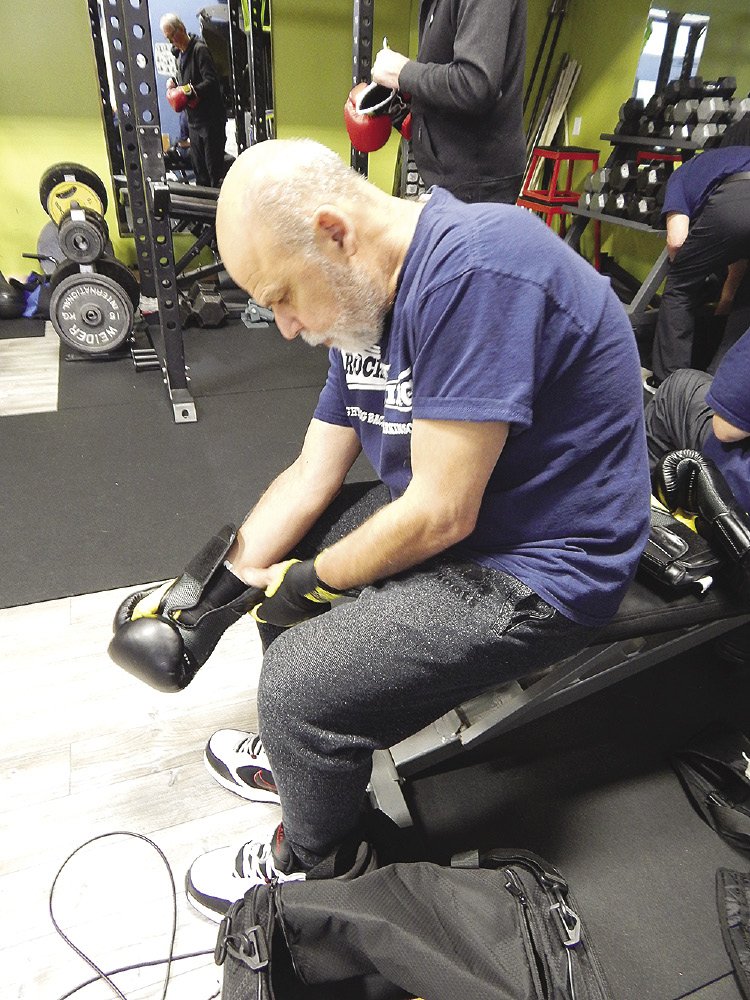“OK, gloves on!” The trainer calls over a soundtrack of ‘80s rock. The participants in the airy gym sit where they can, slip on hand protectors, then colourful boxing gloves. Wearing sweats with navy T-shirts reading “Boxer” on the back, they stand in loose rows with plenty of space between them, adopting the traditional boxing stance. None will touch another.
Their opponent is not human, but rather the ravaging effects of Parkinson’s disease (PD). A neurological condition brought on by the brain’s inability to manufacture dopamine, a hormone and neurotransmitter, PD tends to strike in middle age, though people as young as 30 might experience it. The condition has a range of symptoms and severity, but most people know it as a noticeable muscle tremor.
“I was diagnosed about five years ago. I started shaking a great deal,” says former nurse Jackie Carroll, one of the boxers. “I couldn’t take blood samples or administer needles any longer.”
“I worked in admin,” says Mary L. “My handwriting got smaller and smaller—now it’s illegible.”
Now, Mary L. and Carroll and some 20 other people with Parkinson’s congregate three times a week at the Sweatclub Gym in Thunder Bay to exercise under the direction of gym owner Jacquie Kennedy.
“Now, punch! Punch! Left! Right! Keep it up! Again!” she calls over the music, as the boxers thrust their fists forward in emulation of professional ring fighters. Soon, she changes up the routine to incorporate forward, backward and sideways shuffles along with the punching. While boxing is an important feature of the Rock Steady Boxing regimen, stretches, modified aerobic exercises and weight training are just as important.
“There’s no cure for PD, but exercise is a really good way to manage the symptoms,” Kennedy adds. “I am just so proud of these fighters.”
One of PD’s most insidious effects is the curtailing of movement that most of us take for granted. With PD, you might not swing your arms, your muscles might stiffen, making for an awkward gait; your muscle coordination becomes spotty. And, of course, the tremors.
“It strikes everybody differently,” says Jed Ruberto. “I take dopamine four times a day. Otherwise, I shake so much, I can’t even write my name with a pen.”
Both Ruberto and Carroll are open about their condition, though this raises another, often painful aspect of PD: the social stigma. For this reason, some of the Rock Steady participants are protected by non-disclosure agreements and prefer to have their identities remain a secret.
“I was shopping one time and shaking a lot, when this man comes up to me and says, ‘You need a drink, dear?’” Carroll relates. She quickly set the man straight and received an apology, but she well remembers how furious she felt about his judgment. For his part, Ruberto welcomes more publicity about the condition.
“With stories like this, I won’t have to keep explaining to people why I’m this way,” he says.
Actually, it was the onset of Carroll’s condition that started the entire operation.
“I found this Rock Steady Boxing outfit in Indianapolis and got my certification as a trainer,” Kennedy says. “Then we started it up here about three years ago, and Jackie got her certification as a coach. ESPN did a study and found that boxing is the most strenuous physical exercise you can do.”
“All right, up against the wall!” Kennedy calls out.
“This is my least favourite of the exercises,” Carroll mutters with a wry smile. Soon, the participants are doing wall sits, which powerfully exercise their legs. Over the course of the hour, they will perform a wide variety of strenuous exercises, all designed to keep participants fit, limber, and feeling good about themselves. As with any chronic condition onset, the reality of Parkinson’s can take a toll on mental health.
“The important thing is that it’s not just the physical, but the mental,” says Kennedy. “They develop more self-confidence and form close relationships with people who are in exactly the same situation they are. When people work together, they bond more closely. I love to see that.”
Certainly, the determination on the faces of the participants is witness to their powerful commitment to their own well-being. And there is laughter.
“Now you know how I lost 28 pounds in one year!” quips another boxer, George, as he eases out of the wall sit.
Soon, the participants are shadow boxing, counting and chanting as they lunge and punch. After a good 20 minutes or so, Kennedy has the participants arrange themselves in a loose rectangular formation, again leaving plenty of space between. She tinkers with her tablet, until the familiar American Pie song blasts out of the gym speakers. Now, the participants and volunteer assistants exercise in place, with knee lifts, shuffles, arms windmilling and more, but above all, singing along with the chorus at the top of their lungs.

